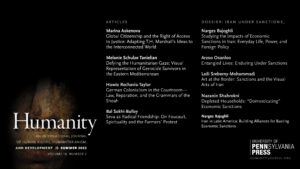Abstract: This article takes Amnesty International’s “Aid and Trade” debate during the late 1970s and early 1980s as a window onto the ways that human rights activists thought about their work and how they understood their organization. It examines the way they grappled with their relationship in to expanding governmental action on human rights, and the meaning of the concepts “effectiveness” and “impartiality,” which were central to Amnesty’s founding.
Current Issue

Our long-awaited issue of Humanity journal is out! Its special dossier, Iran under Sanctions, examines the myriad and devastating impacts of international sanctions on society, culture, and politics. The issue includes an essay on the legal case Herero and Nama v. The Federal Republic of Germany to theorize reparations for German colonialism and slavery as they became linked with the aftermath of the Shoah. It also includes essays on T.H. Marshall and the right of access to justice; visual representations of Armenian genocide survivors; and, the concept of radical friendship in relation to the Farmers’ Protests in India.
View entire issue > Save Save Save
📘'Choose Your Bearing: Édouard Glissant, Human Rights and Decolonial Ethics' is now available for pre-order!
❕Grab your copy and save 30% OFF using the code NEW30 at checkout : https://edin.ac/3JIcRne
@HumanityJ